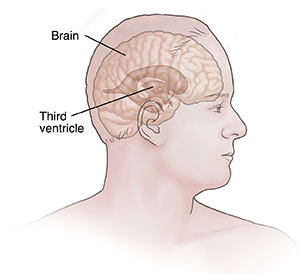A
B
C
D
E
F
G
H
I
J
K
L
M
N
O
P
Q
R
S
T
U
V
W
X
Y
Z
Click a letter to see a list of medical procedures beginning with that letter.
Click 'Back to Intro' to return to the beginning of this section.
Colloid Cyst
A colloid cyst is a type of brain cyst. A brain cyst is an abnormal fluid-filled sac in the brain. The cyst usually contains a thick gel-like substance called colloid. A colloid cyst is generally benign (not cancer). Benign also means that the growth doesn't spread to other parts of the body. Often, a brain cyst starts before birth. A colloid cyst may be present through childhood but not large enough to cause symptoms until adulthood.
How a colloid cyst can cause problems
A colloid cyst often forms on the roof of the third ventricle of the brain. This is a space in the center of the brain that holds cerebrospinal fluid (CSF). A cyst can block the flow of CSF from time to time. It can also cause positional headaches. These are headaches that occur when you are in a certain position. Untreated pressure in the brain caused by colloid cysts can cause bleeding in the brain or sudden death.

What causes a colloid cyst?
Researchers are not yet sure what causes a colloid cyst. The cyst may start to form when a baby’s central nervous system is developing in the womb.
Symptoms of a colloid cyst
A colloid cyst may not cause symptoms until it grows large, usually after age 30. The symptoms depend on which part of the brain the cyst is growing in. Symptoms can occur a bit differently in each person but can include:
A colloid cyst may cause CSF to build up on the brain. This is called hydrocephalus. Hydrocephalus can cause symptoms such as:
-
Confusion
-
Double vision
-
Sleepiness
-
Sudden death (rarely)
-
Trouble walking
Diagnosing a colloid cyst
A colloid cyst may be found when it shows up on an imaging scan done for another reason. In other cases, you may have symptoms from the cyst. Your healthcare provider may refer you to a neurologist. This is a doctor who diagnoses and treats diseases of the central nervous system. Or you may be referred to a neurosurgeon. This is a surgeon who does brain or spinal cord surgery.
Your healthcare provider will ask about your medical history and symptoms. They will give you a physical exam. This may include a neurologic exam. Imaging tests may be done to look at the brain. Contrast dye may be used to help show more detail in the images. The tests may include:
-
CT scan. This is a test that uses a series of X-rays and a computer to create images of the inside of the body. Scans may be done of your brain and spinal cord.
-
MRI. This test uses large magnets and a computer to create images of the body. MRI scans of your brain and spinal cord may be done to get more information about the cyst and nearby tissues.
Scans may be done again over time to see if the cyst is growing.
Treatment for a colloid cyst
A colloid cyst may stay the same size for decades or may grow bigger over time. Cysts that block CSF flow can be life-threatening if untreated. A colloid cyst can be removed with surgery. The size and location of the cyst, as well as any symptoms, will determine if surgery is needed.
Hydrocephalus caused by a colloid cyst is treated with a shunt. This is a small drainage tube put in the brain, which then drains extra CSF into the abdomen. This helps to remove fluid and relieve pressure.
When to call your healthcare provider
Call your healthcare provider right away if you have any of these:
Online Medical Reviewer:
Callie Tayrien RN MSN
Online Medical Reviewer:
Joseph Campellone MD
Online Medical Reviewer:
Raymond Kent Turley BSN MSN RN
Date Last Reviewed:
2/1/2022
© 2000-2024 The StayWell Company, LLC. All rights reserved. This information is not intended as a substitute for professional medical care. Always follow your healthcare professional's instructions.